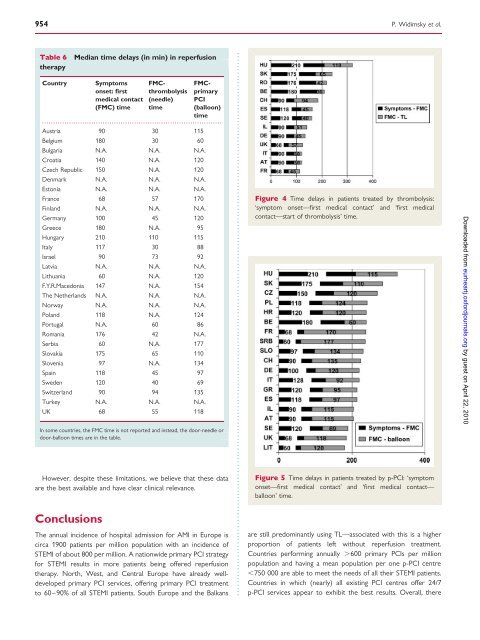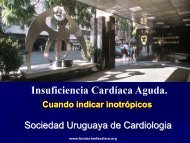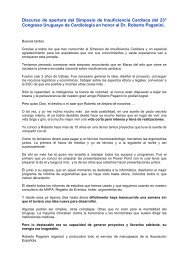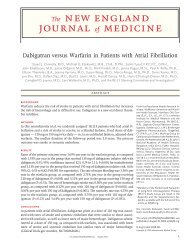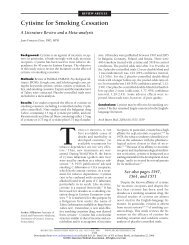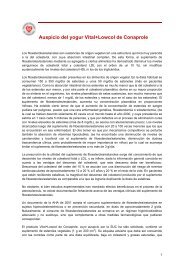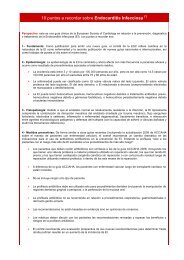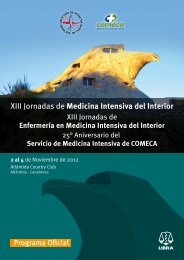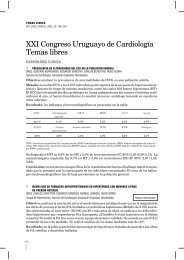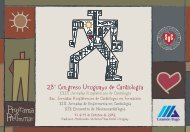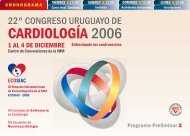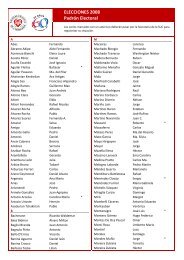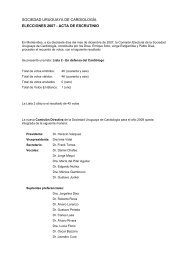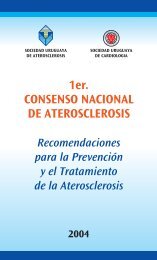Reperfusion therapy for ST elevation acute myocardial infarction in ...
Reperfusion therapy for ST elevation acute myocardial infarction in ...
Reperfusion therapy for ST elevation acute myocardial infarction in ...
Create successful ePaper yourself
Turn your PDF publications into a flip-book with our unique Google optimized e-Paper software.
954<br />
P. Widimsky et al.<br />
Table 6<br />
<strong>therapy</strong><br />
Median time delays (<strong>in</strong> m<strong>in</strong>) <strong>in</strong> reperfusion<br />
Country Symptoms FMCthrombolysiprimary<br />
FMC-<br />
onset: first<br />
medical contact (needle) PCI<br />
(FMC) time time (balloon)<br />
time<br />
................................................................................<br />
Austria 90 30 115<br />
Belgium 180 30 60<br />
Bulgaria N.A. N.A. N.A.<br />
Croatia 140 N.A. 120<br />
Czech Republic 150 N.A. 120<br />
Denmark N.A. N.A. N.A.<br />
Estonia N.A. N.A. N.A.<br />
France 68 57 170<br />
F<strong>in</strong>land N.A. N.A. N.A.<br />
Germany 100 45 120<br />
Greece 180 N.A. 95<br />
Hungary 210 110 115<br />
Italy 117 30 88<br />
Israel 90 73 92<br />
Latvia N.A. N.A. N.A.<br />
Lithuania 60 N.A. 120<br />
F.Y.R.Macedonia 147 N.A. 154<br />
The Netherlands N.A. N.A. N.A.<br />
Norway N.A. N.A. N.A.<br />
Poland 118 N.A. 124<br />
Portugal N.A. 60 86<br />
Romania 176 42 N.A.<br />
Serbia 60 N.A. 177<br />
Slovakia 175 65 110<br />
Slovenia 97 N.A. 134<br />
Spa<strong>in</strong> 118 45 97<br />
Sweden 120 40 69<br />
Switzerland 90 94 135<br />
Turkey N.A. N.A. N.A.<br />
UK 68 55 118<br />
In some countries, the FMC time is not reported and <strong>in</strong>stead, the door-needle or<br />
door-balloon times are <strong>in</strong> the table.<br />
Figure 4 Time delays <strong>in</strong> patients treated by thrombolysis:<br />
‘symptom onset—first medical contact’ and ‘first medical<br />
contact—start of thrombolysis’ time.<br />
Downloaded from eurheartj.ox<strong>for</strong>djournals.org by guest on April 22, 2010<br />
However, despite these limitations, we believe that these data<br />
are the best available and have clear cl<strong>in</strong>ical relevance.<br />
Conclusions<br />
The annual <strong>in</strong>cidence of hospital admission <strong>for</strong> AMI <strong>in</strong> Europe is<br />
circa 1900 patients per million population with an <strong>in</strong>cidence of<br />
<strong>ST</strong>EMI of about 800 per million. A nationwide primary PCI strategy<br />
<strong>for</strong> <strong>ST</strong>EMI results <strong>in</strong> more patients be<strong>in</strong>g offered reperfusion<br />
<strong>therapy</strong>. North, West, and Central Europe have already welldeveloped<br />
primary PCI services, offer<strong>in</strong>g primary PCI treatment<br />
to 60–90% of all <strong>ST</strong>EMI patients. South Europe and the Balkans<br />
Figure 5 Time delays <strong>in</strong> patients treated by p-PCI: ‘symptom<br />
onset—first medical contact’ and ‘first medical contact—<br />
balloon’ time.<br />
are still predom<strong>in</strong>antly us<strong>in</strong>g TL—associated with this is a higher<br />
proportion of patients left without reperfusion treatment.<br />
Countries per<strong>for</strong>m<strong>in</strong>g annually .600 primary PCIs per million<br />
population and hav<strong>in</strong>g a mean population per one p-PCI centre<br />
,750 000 are able to meet the needs of all their <strong>ST</strong>EMI patients.<br />
Countries <strong>in</strong> which (nearly) all exist<strong>in</strong>g PCI centres offer 24/7<br />
p-PCI services appear to exhibit the best results. Overall, there


